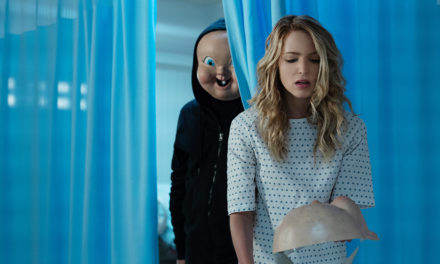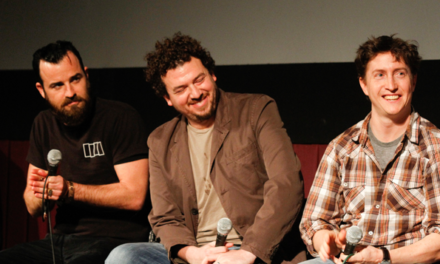Another Christmas season, another new Star Wars film.
When Star Wars returned to the forefront of the pop culture conversation roughly a year ago with the release of The Force Awakens, I questioned whether our cinematic culture needed this franchise back. The first six films united generations and inspired countless young filmmakers with their own visions, so while its importance in the pantheon of watershed films is uncontestable, its purpose in the modern blockbuster sphere is. However, unlike The Force Awakens, which was blatant nostalgia weaponized into guaranteed profit, Rogue One: A Star Wars Story opts to take the universe in a bolder, darker direction that stays true to the franchise’s mythos but gives fans something fresh to chew on.
Preceding the events of A New Hope, this prequel focuses on the Rebel Alliance leading a covert mission to steal the plans for the Death Star. At the center of the film is Jyn Erso (Felicity Jones), the daughter of an Imperial engineer tasked by the Empire to build the Death Star. After being freed by Rebels, Jyn reluctantly tags along to intercept a message delivered by a defected Imperial pilot. Discovering that the message is from her father concerning a weakness in the Death Star’s design, she experiences a change of heart, and along with Rebel officer Cassian Andor (Diego Luna), leads a ragtag team of rebels and mercenaries in a siege on an Imperial base to intercept the plans and transmit them to the Alliance.
At its core, Rogue One is an intergalactic heist film: the Empire is the bank, the Rebels are the thieves and the Death Star plans are the loot. However, such a simplification understates how ingenious the film is at developing the world these characters inhabit. For the first time, we get a real sense of the gritty, morally dubious side of the Rebel Alliance, as our leads are self-proclaimed assassins, thieves and saboteurs. Seriously, some characters make Han Solo look like Luke Skywalker. Realistic character writing adds shades of gray to a universe largely painted in starkly black and white conceptions of good and evil.
From a plot standpoint, the film is rigidly separated into a plodding, exposition-heavy first half and an action-packed, thrilling second half that had me on the edge of my seat. The film unfortunately never quite strikes a fluid transition between these two halves; I was largely bored with the portrayal of Jyn’s backstory and meeting the other Rebels, which felt like a strange amalgamation of Luke and Rey’s introductions from the previous film.
However, once the film’s heist portion kicks in, it goes full throttle into what we’ve been waiting for and more than delivers. The AT-ATs and Rebels storming the beach seen in the trailer are only the tip of the iceberg for what the actual battle entails, as the tension is ratcheted up with each passing moment.
It’s been awhile since a major blockbuster has made the audience feel like something is at stake and while most Star Wars fans will know where the ending is heading, Rogue One gets there in the least expected way possible. Simply put, the ending has balls, and the climactic finale to the battle ends on one of the most beautiful shots I have seen all year.
On the whole, the fan service is handled much better here than it was in The Force Awakens. Whereas the last Disney Star Wars film was so enraptured by its own past mythology that it failed to create anything new, Rogue One is keen to carve its own identity. The film relegates the fan service to brief throwaway lines and character cameos. Barring one glaring choice, the fan favorite characters are handled well, particularly Darth Vader, whose best scenes were fortunately excluded from all the advertising.
Grade: B
SPOILERS
The one major fan service flaw is embodied in Grand Moff Tarkin. If you are keen on Star Wars or cinematic history in general, you’ll probably note that Tarkin actor Peter Cushing has been dead for the better part of 20 years at this point. Since Tarkin was crucial to the development of the Death Star in the original film, I was curious to see how his role would be addressed. Unfortunately, rather than simply recasting the role or keeping Tarkin’s face hidden, the filmmakers opted to develop a CGI Cushing to play the part. Every one of Tarkin’s scenes plays out like live-action actors awkwardly playing against a video game cutscene character put into a film. It wouldn’t be so bad if his appearances were brief, but the movie constantly cuts back to him on the Death Star, making the effect seem all the more hokey.
The other big issue, as I hinted at earlier, is the lead. Jyn is not a particularly unlikable character, but she’s not very charismatic or intriguing as a protagonist whom we want to follow. Jones seems unable to register any expression beyond pouting or staring wide-eyed at the camera, giving me flashbacks to her bland character from Inferno earlier this year. Director Gareth Edwards makes the same mistake he did in his Godzilla reboot a few years back, sacrificing character development in the name of visual scope and grandeur. Far too much screen time is spent on Jyn’s relationship with her father, but it is pointless in the grand scheme of the plot. It feels more like an obligation than anything else, as the visuals are the real treat of the film rather than the characters.
Despite having a Death Star-sized chip on her shoulder that could make for an interesting character, Jyn is made even more milquetoast by a stellar supporting cast who blow her out of the water. Luna imbues Cassian with a sense of Dirty Harry inspired heroics that clash with the more morally sound heroes of prior Star Wars films, giving the film an edge that felt sorely needed. Donnie Yen’s turn as the blind warrior Chirrut Imwe provides some kick-ass fight scenes to the mix, invoking the Asian martial arts influence that the franchise is known for curbing from. My favorite character is easily Alan Tudyk as K-2SO, Cassian’s reprogrammed Imperial droid that has penchant for witty sarcasm. His apathetic demeanor and biting humor are really the heart of this otherwise gritty and downbeat film.
While it’s heavily flawed, Rogue One emerges as a singular vision in the Star Wars franchise. It harkens to the original trilogy, but never feels slavishly controlled by it. It’s blockbuster filmmaking that takes risks, eschewing formula and convention for pure, unfiltered storytelling. This is a direction the franchise needs to go in, allowing directors to use this universe as their canvas on which to paint their personal visions. If Disney were smart enough to follow this approach, I’d say that there’s plenty more excitement in the future of this galaxy far, far away.
Film Critic Vikrant Nallaparaju is a College Sophomore from Houston, Texas studying Anthropology and Human Biology. This is his second year writing for the wheel and the first serving as film a critic. When it comes to movies, he can usually be found watching the films of Joe Dante and lamenting the fall of John Carpenter.







